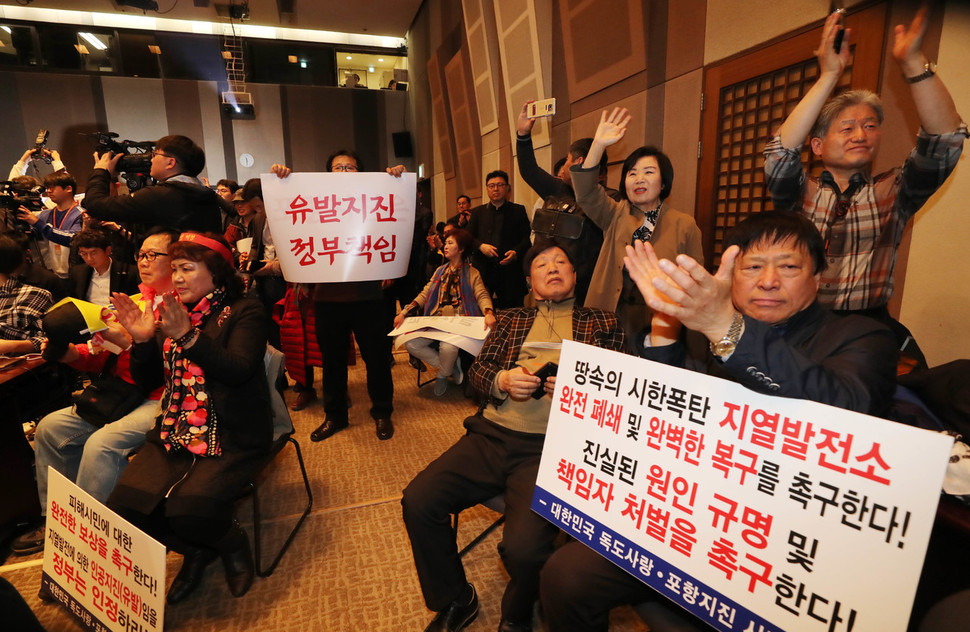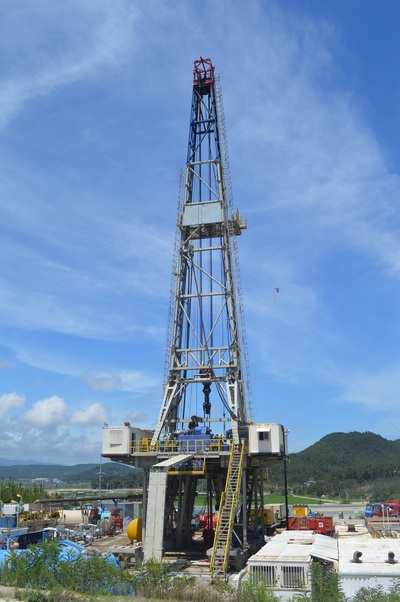Posted on : Mar.24,2019 13:16 KST
 |
|
A press conference hosted by the Geological Society of Korea in Seoul on Mar. 20 to report the findings of a government investigative committee on the causal relationship between the 2017 Pohang earthquake and the geothermal power plant. (Shin So-young, staff photographer)
|
Number of residents in lawsuit likely to increase after government announces investigation report
Government investigation findings attributing a 2017 earthquake in Pohang, North Gyeongsang Province, to drilling and water pumping by the Pohang Geothermal Energy Power Plant has the legal community focusing on the scale and scope of state compensation for the unprecedented “manmade” seismic disaster. In view of the large number of residents affected, some are predicting an “astronomical” sum when the compensation decision comes. A court appraisal of the government investigation cited variables including the scope of government employee responsibility.
 |
|
The construction site of the geothermal power plant in Pohang, North Gyeongsang Province, that’s been suspected of triggering the 5.4-magnitude earthquake in Pohang on Nov. 15, 2017. (provided by academic journal Science)
|
Prior to the government’s publication of its findings, a group of 1,156 Pohang residents – including members of the group Pan-Citizen Headquarters for Countermeasures in Response to the Pohang Earthquake – requested a suit demanding compensation from the state, the geothermal power company Nexgeo, and POSCO, which invested facilities and funding. A similar suit was filed in October 2018 by 71 residents. The number of residents taking part in lawsuits appears likely to grow substantially in the wake of the government investigation report on the earthquake’s cause.
Affected residents claim the government was at fault from the stage of selecting a site for the geothermal power plant.
The complaint filed by the residents with the court stressed the state’s responsibility, claiming that the “construction of a geothermal power plant in Heunghae Township in Pohang’s Buk (North) district, which has the potential for triggering earthquake due to an active fault, was planned at the state level as part of a new and renewable energy project implemented under the Lee Myung-bak administration.”
Issue of whether government was aware of active fault line and ignored it
A judge said on Mar. 21 that factors such as cause-and-effect relationships, deliberateness, and unlawfulness are typically considered when deciding compensation.
“In court, the determination of government fault will focus on whether they knew ahead of time about the active fault’s presence and predicted the possibility of an earthquake,” the judge said. This suggests the battle will focus on whether the government was aware of the active fault line’s presence in the first place, whether it knowingly disregarded it, and, if it was aware, whether it had an objective basis for concluding it presented a low risk when it proceeded with the project.
The findings published by the government do not in themselves offer immediate proof of the government’s responsibility for compensation.
“They would also need to debate the credibility of the investigation findings in court. We’ll have to wait and see how the government responds to these findings going ahead,” said a second judge.
A third judge said, “The announcement is beneficial from the standpoint of the affected residents filing the suit in terms of gaining an early advantage.”
“If the project did go ahead despite government employees predicting the possibility of the earthquake, a high level of liability could be recognized,” the judge predicted.
Incident constitutes environmental pollution
Given the unprecedented nature of the legal battle over an artificially induced earthquake, the residents’ lawyers are working overtime to develop their argument. The position of the attorneys equates the earthquake with its vibrations and the resulting damages. Their argument holds that if the earthquake was triggered by shock waves (vibrations) affecting the fault in the process of pumping water in and out at high pressures, this constitutes an incident of environmental pollution. In particular, they note that the Act on Liability for Environmental Pollution Damage, which was enacted in December 2014, defines damages resulting from “vibrations” as a form of environmental pollution.
The legal representatives are also claiming that POSCO “abetted” the activity.
“POSCO was part of the consortium for the Pohang Geothermal Power Plant,” explained Seoul Central Law Firm attorney Lee Gyeong-woo, who is one of the lawyers tasked with the case.
“Having invested geothermal plant equipment and billions of won in funding for pump rental and other costs, they bear responsibility for compensation,” Lee said.
By Jang Yee-ji, staff reporter
Please direct comments or questions to [english@hani.co.kr]










